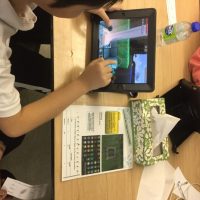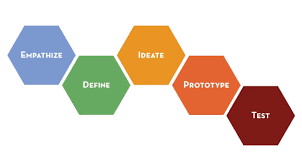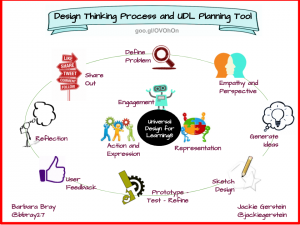Open Creative Spaces
A creative space is a virtual or physical space in which students, educators, parents & community members can collaborate to design, create, and build using physical materials and digital devices. They focus on the process of making not the end product. This allows individuals to make deep connections between concepts, solve real-world problems, develop perseverance, and/or simply create serendipitously. Creative Spaces are informed and inspired by the Art Hives, Maker Movement, and the act of creation that makes us all human.
Creative spaces can take many forms – in fact, no two creative spaces look alike. The physical space can be in a classroom, a library, a designated space in the school, a set of bins in a common area or even a mobile supply cart that you roll into your classroom. If people of different ages and abilities share the space, you’ll need to consider making a range of work surfaces and tools available. Canadian Library Learning Commons is an example of an OCS.
Creative spaces can foster student engagement through active learning with high and low-tech materials. They make use of the Design Process and STEAM to develop the following Cross-Curricular Competencies from the Quebec Education Program:

- Uses information
- Solves problems
- Exercises critical judgment
- Uses creativity
- Adopts effective work methods
- Uses ICT
- Achieves their potential
- Cooperates with others
- Communicates appropriately
When deciding what materials to put in the creative space, it can be helpful to think about the expression “low floor, high ceiling” – that is, tools that are fairly accessible and easy to start with but which have the potential to expand into larger, more complex projects over time. Start with what you already know and have. Creative Spaces may involve:

- coding and programming
- microcontrollers
- robotics
- constructing with cardboard (Low-Tech. STEAM Challenges)
- working with e-textiles and paper circuits (e-textiles STEAM Challenges)
- designing and creating simple machines
- and much more!
This list of available technologies may seem daunting, but your school might have already purchased some equipment. It is important to get the school community involved in decisions about which materials and digital devices will be purchased. You could survey fellow teachers, students, and other community members about their interests to ensure the supplies chosen meet local needs. As a staff, talk about what is happening in classrooms and how a creative space might augment what people are already doing. You may want to start with a list of consumables for parents to donate. As the space develops, so will the tools. All you need to begin is cardboard, duct tape and an open mind!
Remember: What is paramount to creative spaces is not the materials or activities but the emphasis placed on the design process, creation, collaboration, and the Maker Mindset. The materials and tools are simply a mean to an end. Start small and let it grow.
Past Events
Check out the Open Creative Space section of our past events page to view professional development sessions and accompanying resources!
The Mindset
In creative spaces, the focus is on learning and reflection, not the final product. Works-in-progress and final products can be shared to celebrate learning. Creative Spaces provide a context for lifelong learning, interdisciplinary, the development of essential skills, and real-world problem-solving.

The Design Process can be used in a creative space to address authentic issues that arise the your classroom, school, local community or around the globe (such as UN’s Sustainable Development Goals). This approach allows students to become involved in making with a purpose for a specific audience. Here are some activity ideas:
- Use open-ended interdisciplinary challenges as a starting point to learn about a concept, tool, or technology and then take it further;
- Try remixing an existing project to learn about a concept and later build on it;
- Explore different materials and techniques to become familiar with how they work and be inspired to invent and create something new;
- Start with a specific idea and prototype with a variety of materials to see what works best for your creation;
- Repurpose/creative reuse – take objects apart or use recycled materials to make something new;
- Use the opportunity to meet a need at the school by building benches, gardening bins, bat and bird houses, or meet a need in your community;
- Try to fix something that is broken or mend something that is worn out
- Check out our Pinterest Board or some books on creating for more inspiration
Creative spaces are great settings for STEAM learning. STEAM is an integrated, interdisciplinary approach to learning that uses Science, Technology, Engineering, Arts, and Math processes and concepts as anchors to guide student-centred inquiry and experiential learning. It helps to foster critical thinking, creativity, collaboration, and communication while developing competencies and knowledge across subjects by focusing on how they are connected and work together.

Creative spaces also promote Universal Design for Learning. They encourage multimodal ways of learning and representing knowledge. They also use open-ended activities where learners can focus on their interests, develop their abilities, and hone their strengths. Students who struggle academically can be successful through experiential learning activities, while those who thrive academically may face obstacles when there isn’t an obvious path to accomplish a challenge. This provides growth opportunities for all!
“Practice makes perfect” best describes a maker mindset, where abilities can be developed, improved, and expanded upon throughout life. This open mindset champions risk-taking and failure which helps us adapt to and contribute to a world that is constantly changing.
One of the most important roles for teachers in a creative space is to plan learning activities, projects or challenges that allow students room to explore, engage, and evaluate their learning process through making. Since there is an emphasis on process, there must be time to work on and store projects, a wide choice of materials, and lots of room for mistakes and Ah-Ha! Moments.
- Consult members of your school community – staff, students, parents, local experts
- Contact your school board’s local RÉCIT consultants
- Community Partners, ie. Kids Code Jeunesse
- Provincial Conferences ie. QPAT, LCEEQ, CCI
- RemixEd Camp
- Training modules on the Campus RÉCIT site (in French)
- Training modules on the CADRE 21 site (in French)
- Online resources for specific tools and technologies
- Fill out our Professional Development Request Form, and we will RSVP with ways to work together – all free of charge!
Pedagogy
- What are my pedagogical intentions and goals?
- What do I want students to learn and be able to do?
- What subject-specific and cross-curricular competencies do I want students to develop in the creative space?
- What activities and projects will support their learning?
Learning Environment
- What kind of learning environment do we want to create for our students?
- Are we giving them choice in the type of activities and the materials that they will use?
- Are we setting up the space to foster collaboration?
- Are we allowing time for ongoing projects?
Space and Material Management
- Who will have access to the space and/or materials?
- Who will be responsible for the management of the space and materials?
- Who will decide on purchases?
- Who will purchase consumables?
- How will we schedule time?
- Will we embed the creative space into our school timetable?
- Who will be responsible for the space?
- How will the community get involved?
- Who will make community connections?
Digital Devices
- What digital devices will best support our learning in the creative space?
- How can different technologies and materials be used to accomplish our goals?
- How will we make time for teachers and students to experiment with the tools and materials?









